recommended oil PONTIAC GRAND PRIX 1998 Owners Manual
[x] Cancel search | Manufacturer: PONTIAC, Model Year: 1998, Model line: GRAND PRIX, Model: PONTIAC GRAND PRIX 1998Pages: 402, PDF Size: 17.96 MB
Page 217 of 402

The exit speed is usually posted.
Reduce your speed according
to your speedometer, not
to your sense
of motion. After driving for any distance
at higher speeds, you may tend to think you are going
slower than you actually
are.
Before Leaving on a Long Trip
Make sure you’re ready. Try to be well rested. If you
must
start when you’re not fresh -- such as after a day’s
work
-- don’t plan to make too many miles that first part
of the journey. Wear comfortable clothing and shoes you
can easily
drive in.
Is your vehicle ready for a long trip? If you keep it
serviced
and maintained, it’s ready to go. If it needs
service, have it done before starting out.
Of course,
you’ll find experienced
and able service experts in
Pontiac dealerships all across North America. They’ll be
ready and willing to help if you need it. Here are some things you can check before a trip:
0
0
0
0
0
0
0
Windshield Washer Fluid: Is the reservoir
full? Are
all windows clean inside and outside?
Wiper Blades: Are they in good shape?
Fuel, Engine Oil, Other Fluids: Have you checked
all levels?
Lamps: Are they all working? Are the lenses clean?
Tires: They are vitally important to a safe,
trouble-free trip.
Is the tread good enough for
long-distance driving? Are the tires all inflated to the
recommended pressure?
Weather Forecasts: What’s the weather outlook
along
your route? Should you delay your trip a short
time to avoid
a major storm system?
Maps: Do you have up-to-date maps?
4-24
Page 280 of 402
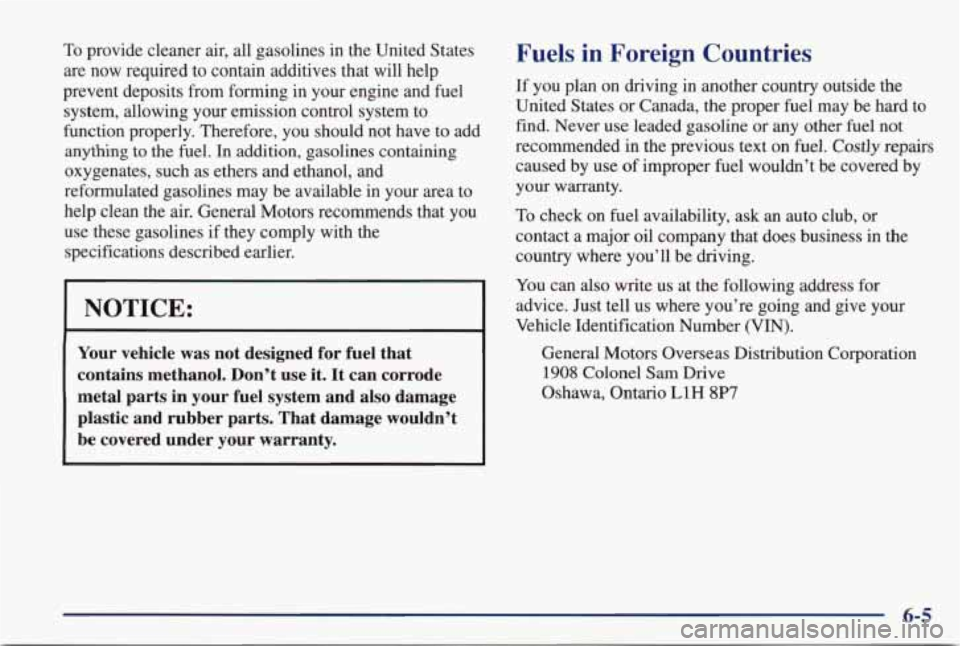
To provide cleaner air, all gasolines in the United States
are now required to contain additives that will help
prevent deposits from forming in your engine and fuel system, allowing your emission control system to
function properly. Therefore, you should not have to add
anythmg to the fuel. In addition, gasolines containing
oxygenates, such as ethers and ethanol, and
reformulated gasolines may be available in your area to
help clean the
air. General Motors recommends that you
use these gasolines if they comply with the specifications described earlier.
NOTICE:
Your vehicle was not designed for fuel that
contains methanol. Don’t use it. It can corrode
metal parts in your fuel system and
also damage
plastic and rubber parts. That damage wouldn’t
be covered under your warranty.
Fuels in Foreign Countries
If you plan on driving in another country outside the
United States or Canada, the proper fuel may be hard to
find. Never use leaded gasoline
or any other fuel not
recommended in the previous text on fuel.
Costly repairs
caused by use
of improper fuel wouldn’t be covered by
your warranty.
To check on fuel availability, ask an auto club, or
contact a major oil company that does business in the
country where you’ll be driving.
You can
also write us at the following address for
advice. Just tell us where you’re going and give your
Vehicle Identification Number (VIN).
General Motors Overseas Distribution Corporation
1908 Colonel Sam Drive
Oshawa, Ontario L1H 8P7
6-5
Page 291 of 402
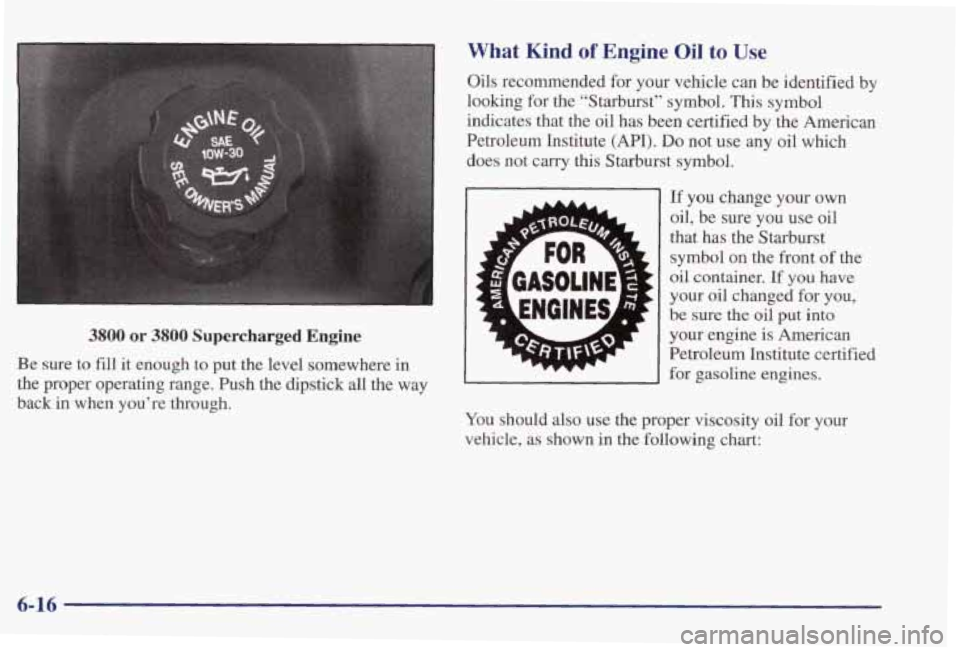
3800 or 3800 Supercharged Engine
Be sure to fill it enough to put the level somewhere in
the proper operating range. Push the dipstick all the way
back in when you're through.
What Kind of Engine Oil to Use
Oils recommended for your vehicle can be identified by
looking for the "Starburst" symbol. This symbol
indicates that the oil has been certified by the American
Petroleum Institute (API).
Do not use any oil which
does not carry this Starburst symbol.
;"vi
.f
If you change your own
oil, be sure you use oil
that has the Starburst
symbol
on the front of the
oil container. If
you have
your oil changed for you,
be sure the oil put into
your engine
is American
Petroleum Institute certifiel
for gasoline engines.
You should also use the proper viscosity oil for your
vehicle, as shown in the following chart:
d
6-16
Page 292 of 402

As shown in the chart, if you have the 3100 engine,
SAE 5W-30 is best for your vehicle. However, you
can use
SAE 1OW-30 if it’s going to be 0°F (-18°C) or
above. These numbers on an
oil container show its
viscosity, or thickness.
Do not use other viscosity oils,
such as SAE 20W-50.
I RECOMMENDED SAE VISCOSITY GRADE ENGINE OILS
FOR BEST FUEL ECONOMY AND COLD STARTING, SELECT THE LOWEST
I SAE VlSCOSlTT GRADE OIL FOR THE EXPECTED TEMPERATURE RANGE.
HOT
WEATHER SYMBOL ---
I
SAE 3w-30 PREFERRED
COLD
WEATHER
DO NOT USE SAE 2OW-50 OR ANY OTHER GRADE OIL NOT RECOMMENDED
3100 Engine
6-17
Page 293 of 402
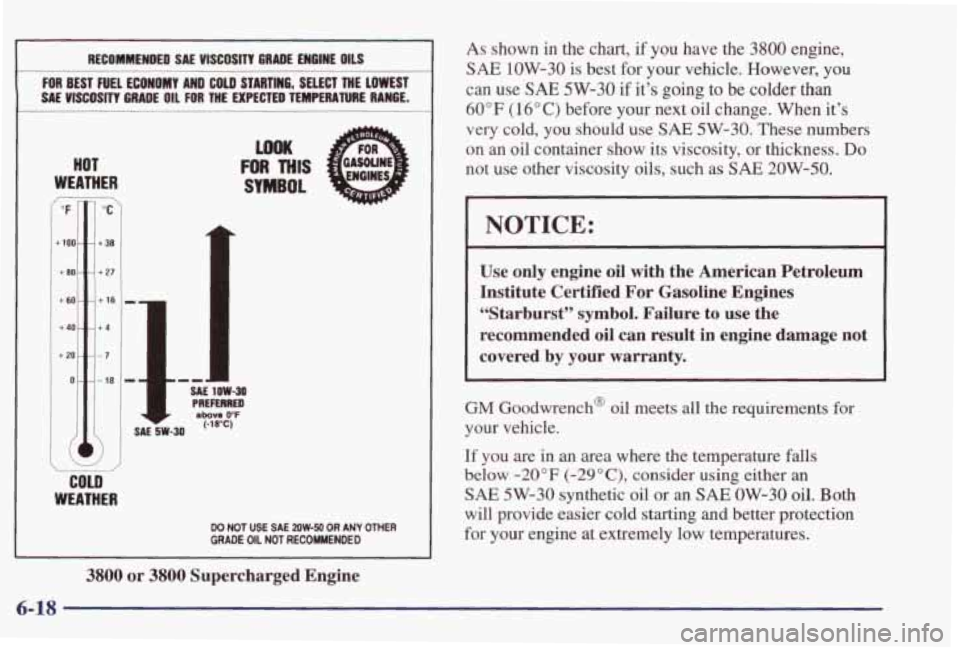
HOT
WEATHER
ImK
FOR THIS
--
RECOMMENDED SAE VISCOSITY GRADE EWGIWE OILS
FOR BEST FUEL ECONOMY AND COLD STARTINO, SELECT THE LOWEST
SA€ UlSCOSlll 6MDE OIL FOR THE EXPECTLD TEMPERATURE WE.
COLD
WEATHER
il UE I lbw-30
PREFERRED &ow 0°F (-1SoC)
DO NOT USE SAE 20W-50 OR ANY OTHER GRADE OIL NOT RECOMMENDED
3800 or 3800 Supercharged Engine
As shown in the chart, if you have the 3800 engine,
SAE 1OW-30 is best for your vehicle. However, you
can use
SAE 5W-30 if it’s going to be colder than
60°F (16°C) before your next oil change. When it’s
very cold, you should use
SAE 5W-30. These numbers
on an oil container show its viscosity, or thickness. Do
not use other viscosity oils, such as SAE 2OW-50.
NOTICE:
Use only engine oil with the American Petroleum
Institute Certified For Gasoline Engines
“Starburst”
symbol. Failure to use the
recommended
oil can result in engine damage not
covered
by your warranty.
GM Goodwrench@ oil meets all the requirements for
your vehicle.
If you are in an area where the temperature falls
below
-20°F (-29”C), consider using either an
SAE 5W-30 synthetic oil or an SAE OW-30 oil. Both
will provide easier cold starting and better protection
for
your engine at extremely low temperatures.
6-18
Page 296 of 402
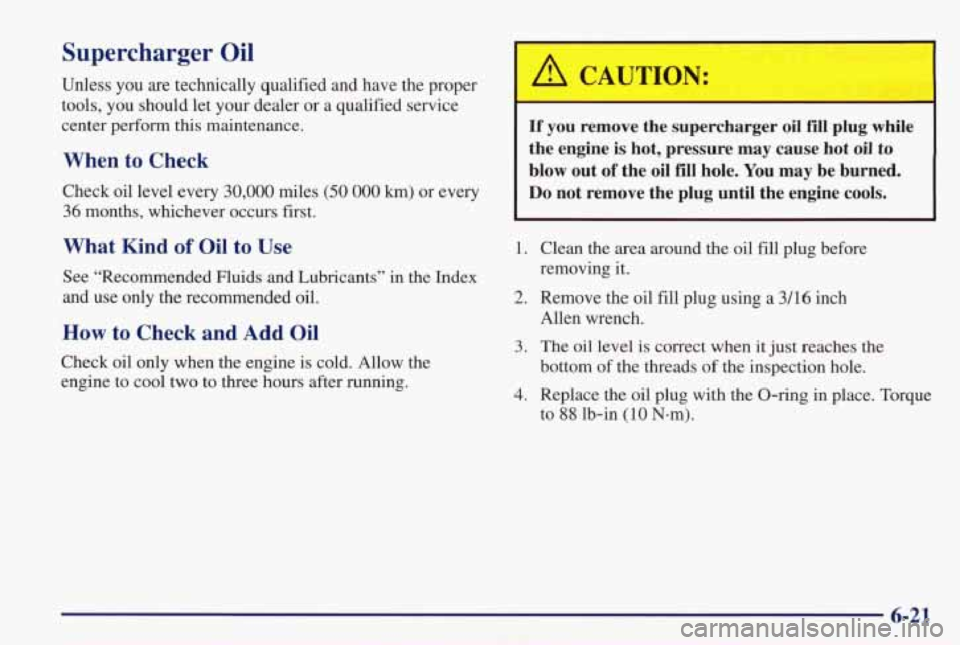
Supercharger Oil
Unless you are technically qualified and have the proper
tools,
you should let your dealer or a qualified service
center perform this maintenance.
When to Check
Check oil level every 30,000 miles (50 000 km) or every
36 months, whichever occurs first.
What Kind of Oil to Use
See “Recommended Fluids and Lubricants” in the Index
and use only the recommended oil,
How to Check and Add Oil
Check oil only when the engine is cold. Allow the
engine to cool two to
three hours after running.
A CAUTION:
If you remove the supercharger oil fill plug while
the engine is hot, pressure may cause hot
oil to
blow out
of the oil fill hole. You may be burned.
Do not remove the plug until the engine cools.
1. Clean the area around the oil fill plug before
2. Remove the oil fill plug using a 3/16 inch
3. The oil level is correct when it just reaches the
bottom
of the threads of the inspection hole.
removing
it.
Allen wrench.
4. Replace the oil plug with the O-ring in place. Torque
to
88 lb-in (10 N-m).
6-21
Page 301 of 402

How to Add Fluid
Refer to the Maintenance Schedule to determine what
kind of transaxle fluid to use. See “Recommended
Fluids and Lubricants” in the Index.
If the fluid level is low, add only enough of the proper
fluid to bring the level into the cross-hatched area on
the dipstick.
1. Pull out the dipstick.
2. Using a long-neck funnel, add enough fluid at the
dipstick hole to bring it to the proper level.
It doesn’t take much fluid, generally less
than one
pint
(0.5 L). Don’t ovefill.
LOTICE:
We recommend you use only fluid labeled
DEXRON@-111, because fluid with that label
is
made especially for your automatic transaxle.
Damage caused
by fluid other than DEXRON-III
is not covered by your new vehicle warranty.
3. After adding fluid, recheck the fluid level as described
4. When the correct fluid level is obtained, push the
under “How to Check” earlier in this section.
dipstick back in
all the way.
Engine Coolant
The cooling s stem in your vehicle is filled with
DEX-COOL engine coolant. This coolant is designed
to remain
in your vehicle for 5 years or 150,000 miles
(240 000 km) whichever occurs first, if you add only
DEX-COOL’ extended life coolant.
The following explains your cooling system and how to
add coolant when it is low. If you have a problem with
engine overheating
or if you need to add coolant to your
radiator, see “Engine Overheating” in the Index.
A 50/50 mixture of water and DEX-COOL’
coolant will:
0 Give freezing protection down to -34°F (-37°C).
Give boiling protection up to 265 OF (129°C).
J
e Protect against rust and corrosion.
e Help keep the proper engine temperature.
0 Let the warning lights and gages work as
they should.
6-26
Page 343 of 402
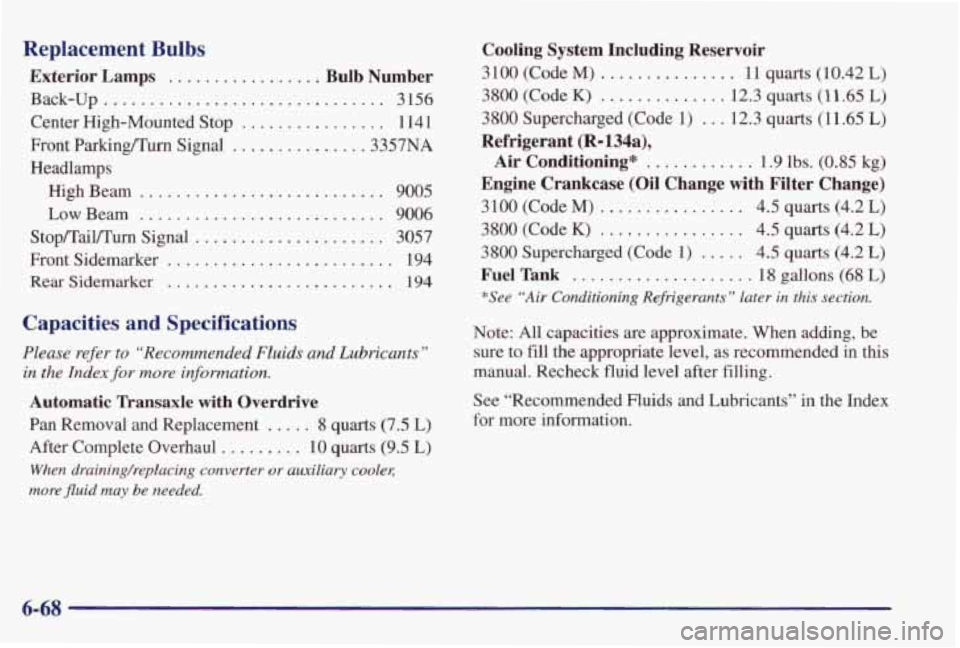
Replacement Bulbs
Exterior Lamps ............... Bulb Number
Back-up ............................... 3 156
Front Parking/Turn Signal
.............. .3357NA
Center High-Mounted Stop
................ 1141
Headlamps HighBeam
........................... 9005
Low Beam ........................... 9006
Front Sidemarker
......................... 194
Rear Sidemarker ......................... 194
Stop/Tail/Turn Signal ..................... 3057
Capacities and Specifications
Please refer to “Recommended Fluids and Lubricants”
in the Index for more information.
Automatic Transaxle with Overdrive
Pan Removal and Replacement ..... 8 quarts (7.5 L)
After Complete Overhaul ......... 10 quarts (9.5 L)
When drainingheplacing converter or auxiliary coolel;
more fluid
my be needed.
Cooling System Including Reservoir
3100 (CodeM) ............... 11 quarts (10.42 L)
3800 (Code K) .............. 12.3 quarts (11.65 L)
3800 Supercharged (Code 1) ... 12.3 quarts (11.65 L)
Refrigerant (R-l34a),
Engine Crankcase (Oil Change with Filter Change)
Air Conditioning*
............ 1.9 lbs. (0.85 kg)
3100 (Code M)
................ 4.5 quarts (4.2 L)
3800 (Code K) ................ 4.5 quarts (4.2 L)
Fuel Tank .................... 18 gallons (68 L)
3800 Supercharged (Code 1) ..... 4.5 quarts (4.2 L)
*See “Air Conditioning Refrigerants ” later in this section.
Note: All capacities are approximate. When adding, be
sure to fill the appropriate level, as recommended
in this
manual. Recheck fluid level after filling.
See “Recommended Fluids and Lubricants” in
the Index
for more information.
6-68
Page 347 of 402
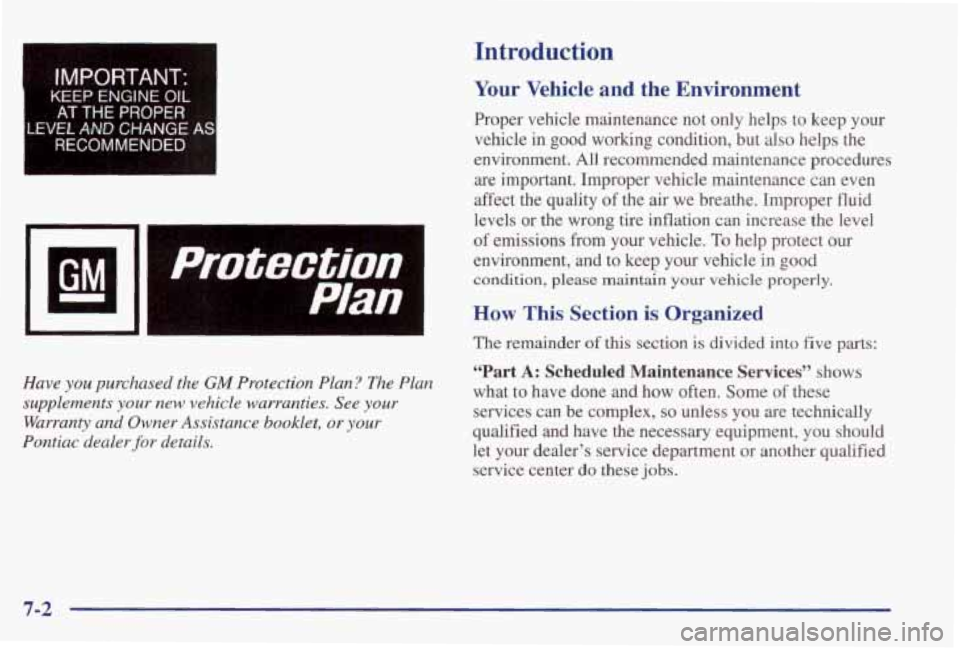
I
tMPORTANT-
KEEP ENGINE OIL
AT THE PROPER
LEVEL AND CHANGE AS
RECOMMENDED I
I
Wl
I Protection 1
Plan
Have you purchased the GM Protection Plan? The Plan
supplements
your new vehicle warranties. See your
Warranty and Owner Assistance booklet, or your
Pontiac dealer for details.
Introduction
Your Vehicle and the Environment
Proper vehicle maintenance not only helps to keep your
vehicle in good working condition, but also helps the
environment.
All recommended maintenance procedures
are important. Improper vehicle maintenance can even
affect
the quality of the air we breathe. Improper fluid
levels or the wrong tire inflation
can increase the level
of emissions from your vehicle.
To help protect our
environment, and
to keep your vehicle in good
condition, please maindn your vehicle properly.
How This Section is Organized
The remainder of this section is divided into five parts:
“Part A: Scheduled Maintenance Services” shows
what to have done and how often. Some
of these
services
can be complex, so unless you are technically
qualified
and have the necessary equipment, you should
let your dealer’s service department
or another qualified
service center
do these jobs.
7-2
Page 350 of 402
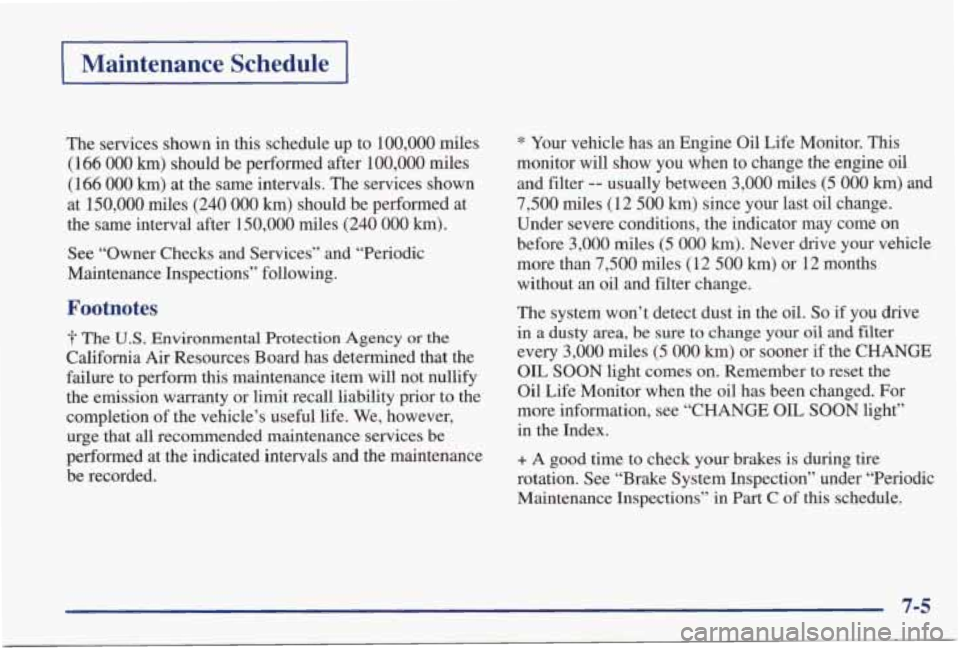
Maintenance Schedule
The services shown in this schedule up to 100,000 miles
(166
OOO km) should be performed after 100,000 miles
(166
000 km) at the same intervals. The services shown
at
150,000 miles (240 000 km) should be performed at
the same interval after 150,000 miles
(240 000 km).
See “Owner Checks and Services” and “Periodic
Maintenance Inspections” following.
Footnotes
? The US. Environmental Protection Agency or the
California Air Resources Board has determined that the
failure to perform
this maintenance item will not nullify
the emission warranty or limit recall liability prior
to the
completion
of the vehicle’s useful life. We, however,
urge that
all recommended maintenance services be
performed at the indicated intervals and the maintenance be recorded.
* Your vehicle has an Engine Oil Life Monitor. This
monitor will show you when to change the engine oil
and filter
-- usually between 3,000 miles (5 OOO km) and
7,500 miles (12 500 km) since your last oil change.
Under severe conditions, the indicator may come
on
before 3,000 miles (5 000 km). Never drive your vehicle
more than
7,500 miles (12 500 km) or 12 months
without
an oil and filter change.
The system won’t detect dust
in the oil. So if you drive
in
a dusty area, be sure to change your oil and filter
every 3,000 miles (5 000 km) or sooner if the CHANGE
OIL SOON light comes on. Remember to reset the
Oil Life Monitor when the oil has been changed. For
more information, see “CHANGE
OIL SOON light”
in the Index.
+ A good time to check your brakes is during tire
rotation. See “Brake System Inspection” under “Periodic
Maintenance Inspections”
in Part C of this schedule.